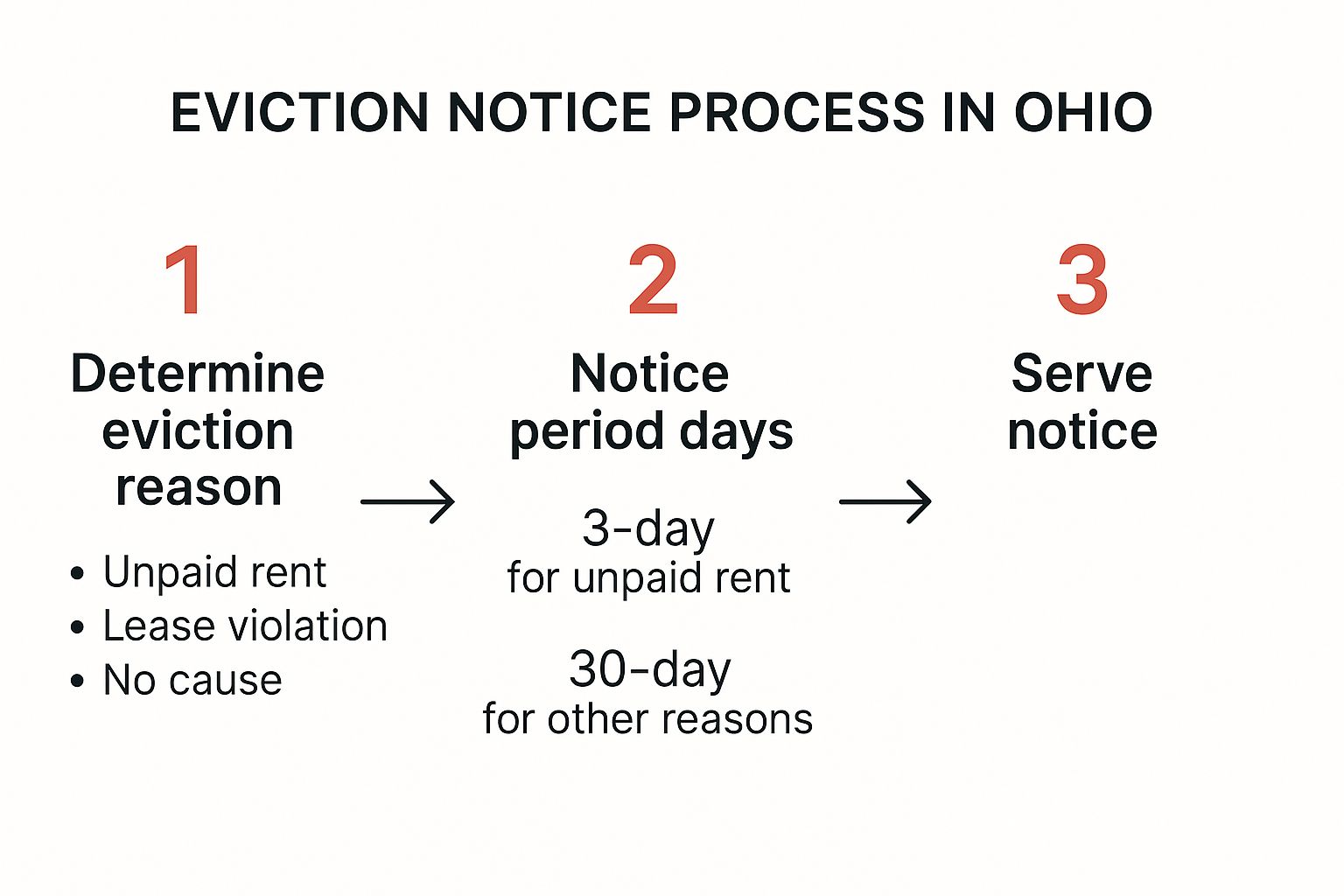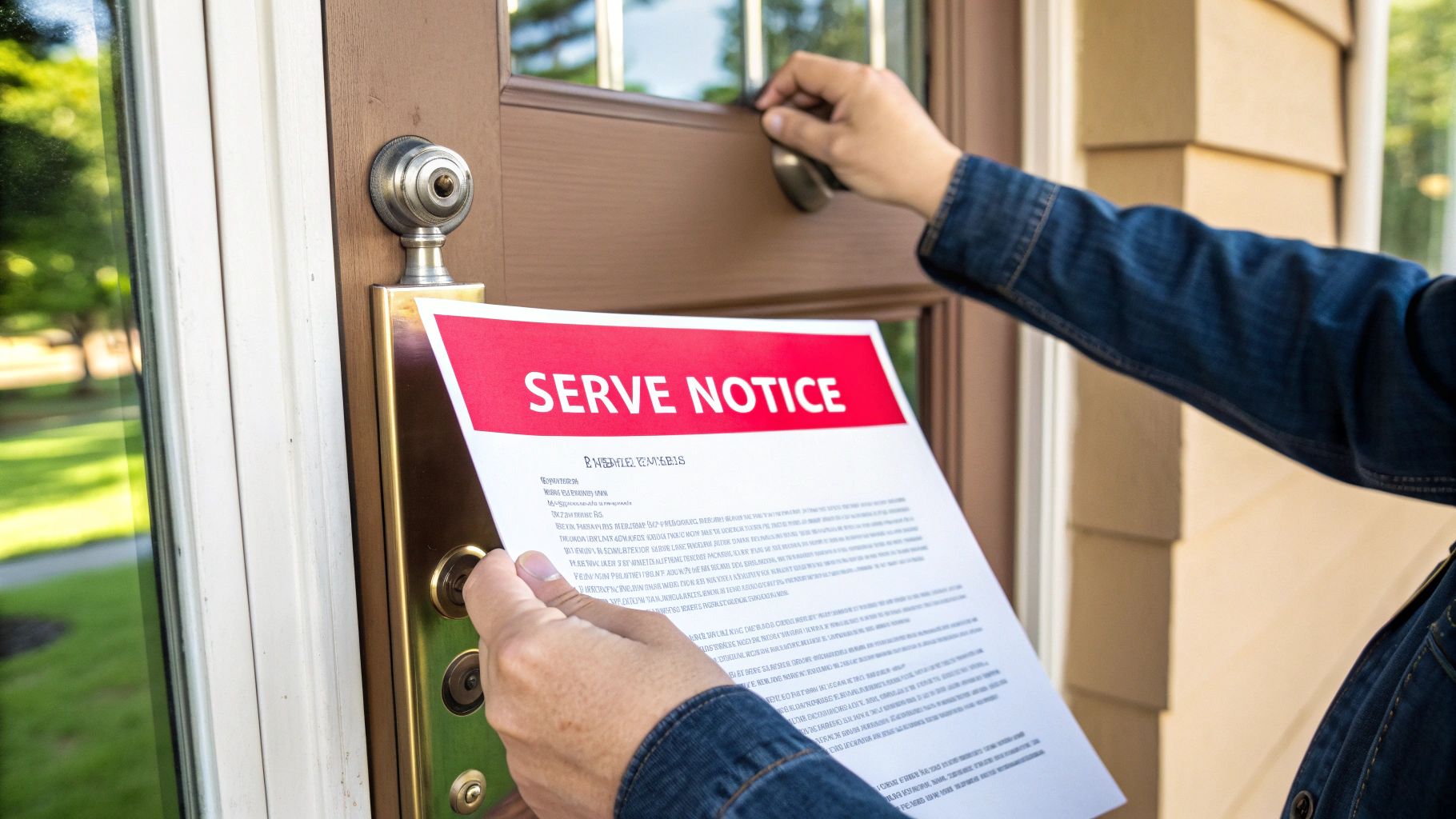Kicking a tenant out in the Cleveland area isn't as simple as changing the locks. The official court process is called a forcible entry and detainer, and it all kicks off with serving a legally sound notice to your tenant. If they don't pack up and leave after that, your next step is filing with the appropriate local court, like the Cleveland Municipal Court. You absolutely cannot take matters into your own hands by tossing their stuff out—there's a strict legal path you have to walk to get your property back.
Understanding the Ohio Eviction Process in Greater Cleveland
When you need to evict a tenant in Ohio, whether you're in Cleveland, Parma, or any of the surrounding suburbs, you're stepping into a formal legal process. This isn't just about asking someone to move; it's a full-blown lawsuit with very specific rules. One wrong move, and you could find your case thrown out by a judge in Lakewood or Euclid, forcing you to start all over again from square one.
The system is set up to balance your rights as a property owner with the tenant's right to housing. For landlords in Northeast Ohio, it's the legal way to reclaim your property when a tenant breaks the lease. The most common reasons I see for eviction are:
- Non-payment of rent: This is, by far, the number one reason for eviction filings in Cuyahoga County.
- Lease violations: This covers a lot of ground, from sneaking in a pet to having unauthorized people living there or causing serious damage.
- Illegal activity: Any criminal acts happening on the property are clear grounds for removal.
- Lease expiration: This happens when a tenant's lease is up, but they refuse to leave and haven't signed a new agreement.
Why Following the Rules Is Not Optional
I can't stress this enough: "self-help" evictions are illegal in Ohio. Trying to force a tenant out by changing the locks, shutting off the water, or moving their belongings will land you in hot water. You could end up being sued by the tenant for some serious damages. The courts here in Cuyahoga County do not take these procedural shortcuts lightly.
The sheer volume of cases shows just how important it is to do this by the book. Back in 2017, Ohio saw a staggering 105,150 eviction filings. That's about 6.7% of all renter households in the state. This number shows how often landlords have to turn to the courts, and it’s exactly why you need to understand the local system inside and out. For more data on Ohio's housing situation, ohiohome.org is a great resource.
A simple procedural mistake isn’t just a minor hiccup. It’s an open invitation for your tenant to fight the eviction, potentially dragging things out for weeks or even months in a local court. That delay costs you more than just time—it costs you lost rent and piles on more legal fees.
To successfully navigate an eviction, you have to treat it like the serious legal action it is. I'll walk you through each step so you know exactly what your obligations are and can move forward with confidence. If you're a property owner dealing with tough tenant situations that are causing major financial strain, it's also smart to be aware of all your options, including understanding the process of foreclosures in Cleveland, Ohio.
Before you even think about filing anything with the Cleveland Municipal Court or your local suburban court, you have to serve your tenant with a proper, legally compliant eviction notice.
I can't stress this enough: this step is not optional. It’s the absolute foundation of your entire case. If you mess up this initial notice, a judge will almost certainly dismiss your eviction lawsuit. That means you're back to square one, wasting valuable time and money.
The All-Important 3-Day Notice
By far, the most common reason landlords in Northeast Ohio start this process is for non-payment of rent. For this, Ohio law is very clear: you must serve a “3-Day Notice to Leave the Premises.”
This isn't just a friendly letter asking them to move out. It’s a formal legal document, and it has to be perfect.
So, what makes it legally valid? The notice must include specific language mandated by Ohio Revised Code § 1923.04. This isn't a suggestion—it's a hard and fast rule.
Your notice needs to prominently feature a statement like this:
“You are being asked to leave the premises. If you do not leave, an eviction action may be initiated against you.”
I've seen cases get tossed out by a magistrate in Euclid or Shaker Heights simply because this exact wording (or something extremely close to it) was missing. This language is critical because it officially informs the tenant of the serious legal trouble they’re in if they don't vacate.
Of course, the notice also has to clearly identify the tenant and the property address. No room for ambiguity here.
The whole point of this strict notice requirement is to give the tenant one last, clear chance to either fix the problem or move out before you drag them into court. It eliminates any chance for them to claim they were caught off guard by a lawsuit.
This first phase is all about precision. The reason for the eviction directly determines which notice you use and how long you have to wait. Getting it right from the jump is everything.

Different Problems, Different Notices
While unpaid rent is the top contender, you’ll encounter other situations that require a different approach. Knowing the nuances is key to legally navigating the Ohio eviction process in the Cleveland area.
Before we dive into the details, here's a quick cheat sheet to help you match the right notice to the right situation.
Ohio Eviction Notice Requirements at a Glance
| Reason for Eviction | Notice Type | Minimum Notice Period | Common Scenario |
|---|---|---|---|
| Non-Payment of Rent | 3-Day Notice to Leave | 3 Days | A tenant is behind on their monthly rent payment. |
| Lease Violation | 3-Day Notice to Leave | 3 Days | A tenant has an unauthorized pet or has damaged the property. |
| Ending a Month-to-Month Tenancy | 30-Day Notice | 30 Days | You want to end a periodic tenancy without a specific cause. |
| Lease Expiration | No Notice Required (Usually) | N/A (30-day courtesy is best practice) | A fixed-term lease is ending, and you don't plan to renew. |
As you can see, the reason dictates the rules. Let's break down a few common scenarios:
- Lease Violations: Let's say your tenant in Lakewood is breaking the rules—maybe they have a dog when the lease says "no pets," or they’ve caused damage. You'll still typically use a 3-day notice. Just make sure you clearly state the specific violation they need to fix.
- Ending a Month-to-Month Tenancy: If you simply want to end a month-to-month lease in Cleveland and there's no specific fault, you need to give more runway. A 30-day notice is required, giving the tenant a fair amount of time to find a new place.
- Lease Expiration: What about when a standard one-year lease is up and you don't want to renew? Legally, you're not always required to give notice unless your lease agreement specifically says you must. But from experience, it’s just good business to give a 30-day courtesy notice. It prevents headaches and misunderstandings.
How to Properly Serve the Notice
The way you deliver the notice is just as critical as what’s written on it. You have to be able to prove to a judge in Cleveland that the tenant actually received it.
Ohio law gives you a few solid options for "service":
- Personal Service: The gold standard. You hand the notice directly to the tenant. My advice? Bring a neutral third-party with you as a witness who can later testify that you delivered the document.
- Leaving it at the Premises: If nobody's home, you can leave the notice in a conspicuous place. Taping it securely to the center of their front door is the most common and accepted method. You absolutely should take a timestamped photo of the notice on the door. This is fantastic evidence.
- Certified Mail: This method gives you a receipt that serves as proof of delivery, which holds up well in court. The downside is that it can slow things down. The three-day clock doesn't start ticking until the tenant actually signs for the letter, which could be days later.
Whatever you do, do not rely on email, text messages, or a verbal warning as your official notice. They simply don't satisfy the legal requirements for service in Ohio. Nail this step, and you can walk into the courthouse to file your complaint with confidence.
Filing Your Eviction Lawsuit in a Local Court
Okay, the three-day notice period is up, and your tenant is still there. Now what? It’s time to take the next step and formally file for eviction. In Ohio, this isn’t just called an eviction lawsuit; it has a specific legal name: a Forcible Entry and Detainer complaint.
This is the point where you officially ask the court to step in. It’s no longer just a dispute between you and the tenant—it’s now a legal case with specific rules, paperwork, and procedures that you have to follow to the letter.

Where to File Your Complaint
First thing's first: you have to file in the right courthouse. This isn't optional, and getting it wrong is a rookie mistake that will get your case thrown out before it even starts. You’ll be back at square one, out of your filing fee, and even further behind schedule.
The lawsuit must be filed in the municipal court that has jurisdiction over your rental property's address. For landlords in Northeast Ohio, this can get a little confusing.
- Cleveland Properties: If your rental is in the city of Cleveland, you’ll be heading to the Cleveland Municipal Court's Housing Division. They handle all cases within the city limits.
- Suburban Properties: For properties in suburbs like Euclid, Shaker Heights, or Lakewood, you'll file at that specific city’s municipal court.
Always, always double-check the court's jurisdiction for your property’s address before you even think about filling out the paperwork.
Assembling the Right Paperwork
The heart of your eviction case is the official complaint form. You can usually pick these up directly from the clerk of court’s office, and many local courts now have them available for download on their websites.
When you fill out the complaint, accuracy is everything. You need to list the full, legal names of every adult tenant on the lease—no nicknames or partial names. You’ll also need to attach a copy of the 3-Day Notice to Leave that you served. This is your proof that you followed the law and gave the tenant proper warning.
Filing the complaint is more than just paperwork; it’s your formal petition to the court. Every detail, from the tenant’s name to the property address, must be perfectly accurate. A simple typo can create delays or even grounds for dismissal.
Once the form is complete, you’ll file it with the clerk and pay the filing fee. This fee varies from court to court but typically runs between $100 and $150. This covers the court’s administrative costs and, importantly, the cost of having the tenant officially served with the lawsuit.
Understanding the Summons and Service
After you’ve filed, the court issues a summons. This is a legal document that formally notifies the tenant that they are being sued for eviction. It will also state the exact date, time, and location of the court hearing.
The court handles getting this notice to the tenant, a process called "service." A bailiff or sheriff's deputy will either hand-deliver the complaint and summons to the tenant or post it prominently on their door. This step is non-negotiable. Without official service, the court doesn’t have jurisdiction, and your case can't move forward.
Hearings in local Cleveland-area courts are typically scheduled very quickly, often within 7 to 14 days of your filing date.
This is a critical waiting period. The reality is that courts are dealing with a high volume of these cases. Housing instability is a major issue across the state; about 46.7% of Ohio renters are considered rent-burdened, meaning they pay over 30% of their income on housing, which often leads to these situations. It's a key factor driving evictions in cities like Cleveland. You can discover more insights about these housing trends in Ohio.
This context helps explain why the process is so structured and fast-paced. Right now, your job is to prepare for your day in court.
How to Prepare for Your Eviction Hearing
The court hearing is the moment of truth in any eviction. Whether you find yourself in the Cleveland Municipal Court or a smaller suburban one like Lakewood's, this is your shot to formally present your case to a judge or magistrate. Just showing up won’t cut it; your success hinges entirely on how well you prepare.
Walking into that courtroom disorganized is one of the fastest ways I’ve seen landlords lose an otherwise open-and-shut case. The judge expects you to have all your ducks in a row. This means bringing professional, organized documents that tell a clear, undeniable story of why the eviction is necessary.

Your Essential Document Checklist
Think of your evidence as the building blocks of your case. Without them, your claims are just words. You absolutely must bring organized copies of every relevant document to prove your side of the story.
Before you head to the courthouse, triple-check that you have these items ready to go:
- The Original Lease Agreement: This is the contract, the foundation of the tenancy. The judge will want to see the specific terms the tenant agreed to and allegedly violated.
- The Eviction Notice: Bring the exact copy of the 3-Day Notice (or other relevant notice) you served. Make sure it's the one with the dates clearly visible.
- Proof of Service: This one is critical. You have to prove you delivered that notice legally. This could be a timestamped photo of the notice posted on the door, a certified mail receipt, or a signed statement from a witness who saw you post it.
- Rent Payment Records: For non-payment cases, a clear, easy-to-read ledger is non-negotiable. It needs to show every payment received, the date it was credited, and the current outstanding balance.
- Communication Records: Printouts of relevant emails, text messages, or formal letters between you and the tenant can provide crucial context for the judge.
- Evidence of Violations: If the eviction is for something other than rent—say, property damage—bring your proof. This means clear photos or videos of the damage, copies of formal written complaints from neighbors, or police reports.
My advice? Organize everything neatly in a binder with labeled tabs. When the magistrate asks for the payment ledger, you want to be able to flip right to it, not fumble through a messy stack of papers. It shows you’re a professional.
What to Expect in the Courtroom
Eviction hearings in Ohio, especially in busy courts like Cleveland's, move fast. Don’t be surprised to find yourself in a room with many other landlords and tenants waiting for their cases to be called.
When it’s your turn, you'll stand before the judge or magistrate. Speak clearly, stick to the facts, and remain professional. This isn't the time for a long, dramatic story or to vent your frustrations.
The court wants to know four basic things:
- Is there a valid lease?
- Did the tenant violate that lease (e.g., fail to pay rent)?
- Did you serve a legally compliant notice to the tenant?
- Did you follow all the correct legal procedures to get here?
Be ready for the tenant to tell their side. They might claim you failed to make repairs or that they tried to pay you and you refused. This is where your organized documentation becomes your best defense. If they claim they paid, you present your pristine payment ledger. Problem solved.
Remember, the burden of proof is on you, the landlord. You must convince the court that you have a legal right to reclaim your property. A lack of evidence is a failure to meet that burden.
Understanding Potential Outcomes
Your hearing will almost certainly end in one of three ways. First, you could get a judgment in your favor. This is the win—the judge agrees with your case and officially grants the eviction.
Second, the case could be dismissed. This is a loss, and it usually happens because of a procedural error on the landlord's part, like a faulty notice or improper service.
Third, the judge might grant a continuance, which just means the hearing is rescheduled. This often happens if the tenant asks for more time to find a lawyer. Knowing these potential outcomes helps you manage your expectations and be ready for whatever comes next.
What to Do After You Win in Court
Winning your eviction case in a Cleveland or Lakewood municipal court feels like the finish line, but there’s one crucial phase left. You've got the judge's decision—the judgment for possession—which is your legal green light. But it doesn't magically make the tenant disappear.
The process isn't truly over until you have the keys back in your hand and the property is officially yours again. This final stage is all about enforcement. Even with a court order, you can't just change the locks or toss their stuff on the curb. That's still illegal. You have to follow the legal procedure to have the tenant physically removed if they refuse to leave.

The Writ of Restitution and the Bailiff
So, what happens if the tenant doesn't vacate within the timeframe the judge ordered? This is usually between five and ten days in Ohio. Your next move is to file for a Writ of Restitution.
This is the legal document that officially authorizes law enforcement to remove the tenant. You'll file a request for it with the same court clerk where your hearing was held and pay a small additional fee.
Once the writ is issued, the court’s bailiff or a county sheriff's deputy takes over. They will post a notice on the tenant's door—often a brightly colored paper known as a "red tag" in many parts of Northeast Ohio. This is the tenant's final warning, giving them a specific date and time by which they must be gone. This window is typically very short, sometimes as little as 24 hours.
The Writ of Restitution transforms the court's judgment into direct action. It's the final, non-negotiable step that empowers law enforcement to legally enforce your right to the property, ensuring the tenant's removal is handled lawfully and safely.
The day the bailiff returns to execute the writ is called the "set-out." As the landlord, you absolutely must be there.
Your Responsibilities on Set-Out Day
The set-out is a coordinated effort, and your preparation is key to making it go smoothly. The bailiff is there to keep the peace and oversee the removal, but the actual physical work falls to you.
Here’s what you need to have ready:
- A Locksmith: Have a locksmith scheduled to be at the property at the exact time of the set-out. Their first job is to change the locks the moment the bailiff has officially cleared the unit. This is critical to prevent the tenant from trying to get back in.
- A Moving Crew (If Necessary): The bailiff will not physically move the tenant’s belongings. Depending on local court rules, you might need a crew ready to move the tenant's personal property to the curb. It's smart to check the specific policies of the Cleveland, Euclid, or Parma municipal courts beforehand to know what's expected of you.
Your job on set-out day is to facilitate the process under the bailiff's supervision. Once the property is secured and the locks are changed, you have officially regained legal possession. This whole situation can be draining, and for some landlords, it's the final straw. If you're tired of the landlord life and wondering "where we buy houses", selling your property quickly in Cleveland might be the next best step.
Handling Abandoned Personal Property
One of the trickiest parts of the aftermath is dealing with anything the tenant leaves behind. You can't just throw everything in a dumpster. Ohio law considers this abandoned property, and you have a legal duty to handle it correctly.
While Ohio law isn't as detailed as some other states, the expectation is clear: you must make a reasonable effort to notify the tenant and give them a fair chance to get their stuff. If you don't, they could sue you later for the value of their property.
To protect yourself, follow these best practices:
- Document Everything: Before you touch a single item, take clear photos and videos of everything left behind. Create a detailed inventory list. This is your proof.
- Send Written Notice: Send a letter via certified mail to the tenant's last known address (and any forwarding address you have). In the letter, list the abandoned items and set a reasonable deadline for them to claim everything, like 10 to 14 days.
- Store the Property Safely: You need to keep the items in a secure location. This could be the rental unit itself, a garage, or even a small storage unit.
If the tenant doesn't claim their belongings by the deadline, you are generally free to dispose of it. Following these steps creates a paper trail that proves you acted in good faith, protecting you from future legal trouble and finally closing the chapter on this eviction.
Common Questions About Ohio Evictions in the Cleveland Area
The Ohio eviction process can feel like a maze. Landlords in the Cleveland area are often left with urgent questions, especially when faced with a tricky tenant situation. Getting the right answer is key to staying on the right side of the law.
Let's dive into some of the most common questions we hear from property owners just like you.
Can I Change the Locks If My Tenant Stops Paying Rent?
Absolutely not. This is probably the single most important rule to burn into your memory.
Taking matters into your own hands—changing the locks, shutting off the utilities, tossing their stuff on the curb—is what the law calls a "self-help" eviction. And in Ohio, it's completely illegal. Doing this can backfire in spectacular fashion, opening you up to a lawsuit where the tenant can sue you for significant damages.
The only way to legally remove a tenant in Cleveland is to follow the court process from start to finish. No shortcuts.
What if the Tenant Offers to Pay After I Serve Notice?
This happens all the time, and you have to handle it carefully. Let's say you've served the 3-Day Notice to a tenant in Parma or Euclid. If they offer to pay the full amount of rent due before you've actually filed the eviction with the court, Ohio law generally says you have to accept it.
Once you take that full payment, the violation is "cured," and that specific eviction process stops in its tracks.
But what about partial payments? That's a different story. You are under no obligation to accept less than the full amount. Be warned: if you accept a partial payment after that 3-day notice period is up, a court could see it as you waiving your right to evict. You’d have to start the whole process over again.
Pro Tip for Landlords: Accepting partial rent can unintentionally hit the reset button on your eviction. It's often smarter to either politely refuse the partial payment and proceed with filing, or talk to an attorney about drafting a formal payment agreement that protects your legal rights.
How Long Does an Eviction Take in the Cleveland Area?
The timeline for an eviction in Cuyahoga County can be all over the map. In a perfect world, an uncontested eviction—meaning the tenant doesn't fight it or even show up to court—can move along pretty quickly.
Here’s a rough breakdown of that best-case scenario:
- Notice Period: 3 days
- Filing to Hearing: Usually about 1-2 weeks
- Post-Judgment Move-Out: The judge typically gives 5-10 days
- Writ of Restitution (if they still won't leave): Add a few more days for the bailiff to post the "red tag" notice.
All in, a smooth eviction might take around 3 to 5 weeks from the day you serve the notice to the day the bailiff schedules the final move-out.
But that timeline is far from guaranteed. If the tenant contests the eviction, asks the court for more time to find a lawyer, or files an appeal, the whole process can drag on for months. For more answers to your landlord questions, feel free to check out our frequently asked questions page.
Navigating tenant issues and the eviction process is exhausting. If you're a landlord in Northeast Ohio who is tired of the cycle and just wants a clean exit, Home Sweet Home Offers is here to help. We give fair, fast offers for rental properties, letting you sell your house without the stress, the repairs, or the drama.

